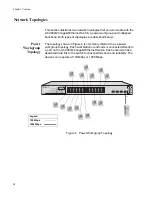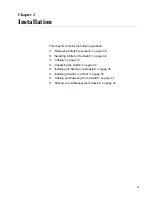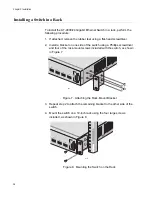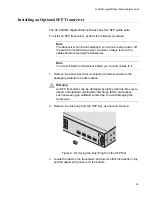
AT-9000/24 Gigabit Ethernet Switch Installation Guide
25
sending data. This can occur under several circumstances. For example, if
two end nodes are operating at different speeds, the switch, while
transferring data between the end nodes, might need to instruct the faster
end node to stop transmitting data to allow the slower end node to catch
up. An example of this would be when a server operating at 100 Mbps is
sending data to a workstation operating at only 10 Mbps.
How a switch signals an end node to stop transmitting data differs
depending on the speed and duplex mode of the end node and switch
port. A twisted pair port operating at 100 Mbps and half-duplex mode will
stop an end node from transmitting data by forcing a collision. A collision
on an Ethernet network occurs when two end nodes attempt to transmit
data using the same data link at the same time. A collision causes end
nodes to stop sending data. When the switch needs to stop a 100 Mbps,
half-duplex end node from transmitting data, it forces a collision on the
data link, which stops the end node. When the switch is ready to receive
data again, the switch stops forcing collisions. This is referred to as back
pressure.
A port operating at 100 Mbps and full-duplex mode uses PAUSE frames,
as specified in the IEEE 802.3x standard, to stop the transmission of data
from an end node. Whenever the switch wants an end node to stop
transmitting data, it issues this frame. The frame instructs the end node to
cease transmission. The switch continues to issue PAUSE frames until it is
ready again to receive data from the end node. This is referred to as flow
control.
The AT-9000/24 Gigabit Ethernet Switch supports both TX and RX flow
control.
Summary of Contents for AT-9000/24
Page 1: ...613 000239 Rev A Layer 2 Gigabit Ethernet Switch AT 9000 24 Installation Guide...
Page 6: ...Contents 6 Appendix B Translated Safety Statements 53...
Page 8: ...Figures 8...
Page 10: ...Tables 10...
Page 28: ...Chapter 1 Overview 28...
Page 46: ...Chapter 2 Installation 46...
Page 48: ...Chapter 3 Troubleshooting 48...
Page 52: ...Appendix A Technical Specifications 52...
Page 74: ...Appendix B Translated Safety Statements 74 1 1 2 3 LAN 4 5 6 I 7 8 9 40 C 10 11 15 LAN OFF 12...
















































